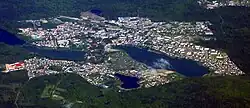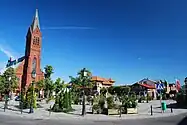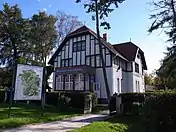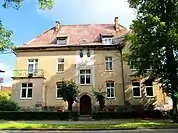Kartuzy
Kartuzy ([karˈtuzɨ]) (Kashubian Kartuzë, Kartëzë, or Kartuzé;[1] formerly German: Karthaus) is a town in northern Poland, located in the historic Eastern Pomerania (Pomerelia) region. It is the capital of Kartuzy County in Pomeranian Voivodeship.
Kartuzy | |
|---|---|
 Kartuzy from a bird's-eye view | |
 Flag  Coat of arms | |
 Kartuzy | |
| Coordinates: 54°20′N 18°12′E | |
| Country | |
| Voivodeship | |
| County | Kartuzy |
| Gmina | Kartuzy |
| Established | 1381 |
| Town rights | 1923 |
| Government | |
| • Mayor | Mieczysław Gołuński |
| Area | |
| • Total | 6.23 km2 (2.41 sq mi) |
| Elevation | 42 m (138 ft) |
| Population (2006) | |
| • Total | 15,263 |
| • Density | 2,400/km2 (6,300/sq mi) |
| Time zone | UTC+1 (CET) |
| • Summer (DST) | UTC+2 (CEST) |
| Postal code | 83-300 |
| Area code | +48 58 |
| Car plates | GKA |
| Website | http://www.kartuzy.pl |
Geographical location
Kartuzy is located about 32 kilometres (20 miles) west of Gdańsk and 35 km (22 miles) south-east of the town of Lębork on a plateau at an altitude of approximately 200 metres (656 feet) above sea level in the average. The plateau, which is divided by the Radaune lake, comprises the highest parts of the Baltic Sea Plate. In the west of this lake are the highest points of the headwaters of rivers Łeba, Słupia and Bukowina at an altitude of up to 271 metres (889 feet). A hill in the south of the lake is 331 metres (1,086 feet) high.[2]
History
.jpg.webp)
Kartuzy was established about 1380 as a monastery for Carthusian monks descending from Prague in the Kingdom of Bohemia, after whom it received its name. The charterhouse was vested with large estates by the State of the Teutonic Order. According to the Second Peace of Thorn the area returned to the Kingdom of Poland in 1466, within which it was administratively part of the Pomeranian Voivodeship in the provinces of Royal Prussia and Greater Poland.
The Carthusian monks had the nearby woodlands cleared out, and peasants from the neighbouring Duchy of Pomerania were encouraged to settle and farm in the newly cleared areas. During the course of the Protestant Reformation Kartuzy and its surrounding area were incorporated into the possessions of Cistercian Oliwa Abbey in 1565. The area was annexed by Prussia in the First Partition of Poland in 1772.
The Prussian government finally dissolved the monastery in 1826. Around that time the settlement was fairly insignificant. It began to play a greater economic role after 1841 when the lands of the monastery were parcelled out.
From 1871 to 1920 it was also part of the German Empire and belonged to the Karthaus district in Regierungsbezirk Danzig in the Prussian Province of West Prussia. In 1894, Kartuzy, then officially Karthaus, was connected to the Praust (Pruszcz Gdański)-Lauenburg (Lębork) railway line of the Prussian State Railway. At the turn of the 20th century, the town had a Protestant church, a Catholic church and a synagogue. The town was appreciated as a climatic type of health resort. Many pensioners and other retired persons settled down here. According to the census of 1910, Karthuas had a population of 3,699, of which 1,937 (52.4%) were Germans, 1,696 (45.9%) were Kashubians and 50 (1.4%) were Poles.[3]
When after World War I the regulations of the Treaty of Versailles became effective in 1920, Kartuzy was reintegrated into the re-established Polish Republic where it was the seat of the Kartuzy County within the Pomeranian Voivodeship and in 1923 it was granted town rights.
After the invasion of Poland, which started World War II, Kartuzy was occupied by Germany, where it was administered as part of the newly formed province of Reichsgau Danzig-West Prussia, Regierungsbezirk Danzig. In mid-September 1939 the SS Wachsturmbann "Eimann" and Einsatzkommando 16 entered the town to carry out mass arrests and massacres of local Poles as part of the Intelligenzaktion Pommern.[4] Around 4,000 Poles from Kartuzy and the county were arrested in September 1939.[5] That same month, many local pre-war Polish activists, as well as railway, post and court employees, were murdered in massacres in the forests in Gmina Somonino and at the Wzgórze Wolności, while 10 Polish priests were murdered in the forest near Kartuzy (see: Nazi persecution of the Catholic Church in Poland).[5] Dozens of Poles from Kartuzy, including local officials, teachers, merchants, postmen, restaurateurs, policemen were murdered in October and November 1939 in the nearby forest and in Piaśnica.[6] Poles from the village of Egiertowo were also murdered in the Kartuzy forest.[7] At the end of World War II Kartuzy was captured by the Red Army and afterwards it was restored to Poland.
Kartuzy has long been a cultural center of the Kashubians. Since 1947 a Kashubian Museum has featured numerous exhibits connected to Kashubia and its inhabitants. The town has also set up a bust to honor Dr. Aleksander Majkowski, author of The Life and Adventures of Remus, who practiced medicine in Kartuzy for a time and is buried here. In 2010, the Kashubian Unity Day was held here. On March 28, 2010, after the Holy Mass in the fourteenth-century collegiate church, Kashubes in colorful regional costumes with black-and-yellow flags passed through the streets to the Team of Schools No. 2 for Wybicki's Estate where the main celebrations were held.
The town was administratively part of the Gdańsk Voivodeship from 1975 to 1998.
Coat of arms
A coat of arms for Kartuzy was designed by Dr. Aleksander Majkowski and accepted by the city council on January 31, 1923. The coat of arms depicts a black Kashubian Griffin and seven silver stars on a blue background.
Population by year
| Year | Number | Remarks |
|---|---|---|
| 1831 | more than 400 | |
| 1869 | 1,765 | |
| 1875 | 1,975 | |
| 1880 | 2,179 | |
| 1885 | 2,300 | |
| 1890 | 2,351 | |
| 1895 | 2,377 | |
| 1900 | 2,642 | |
| 1921 | 3,800 | |
| 1943 | 6,024 | |
| 1960 | 7,900 | |
| 1970 | 10,600 | |
| 1975 | 11,600 | |
| 1980 | 12,000 | |
| 1998 | 16,100 | |
| 2004 | 15,472 | |
| 2009 | 14,951 |
Sports
The local football club is Cartusia Kartuzy, founded in 1923. It competes in the lower leagues.
Notable people

- Aleksander Majkowski (1876–1938), writer, poet, journalist, editor, activist and physician
- Jan Rompsczi (1913–1969), activist, poet, writer, journalist and ethnographer
- Zenon Kitowski (born 1962), clarinet player
- Andrzej Wroński (born 1965), Greco-Roman style wrestler, gold medallist at the 1988 and 1996 Summer Olympics, carried the flag at the opening ceremony of the 2000 Summer Olympics
- Wojciech Kasperski (born 1981), screenwriter, film director and producer
- Piotr Chrapkowski (born 1988), handball player
- Angelika Cichocka (born 1988), middle-distance athlete
- Szymon Sajnok (born 1997), road and track cyclist
%252C_Gda%C5%84ska_10_-_fotopolska.eu_(236848).jpg.webp)
External links
References
- "Lista gmin wpisanych na podstawie art. 12 ustawy z dnia 6 stycznia 2005 r. o mniejszościach narodowych i etnicznych oraz o języku regionalnym (Dz. U. z 2015 r. poz. 573) do Rejestru gmin, na których obszarze używane są nazwy w języku mniejszości" (PDF). mswia.gov.pl. Archived from the original (PDF) on 2016-03-04. Retrieved 2016-04-26.
- Meyers Konversations-Lexikon, 6th edition, Vol. 10, Leipzig and Vienna 1907, p. 688.
- Landesamt, Prussia (Kingdom) Statistisches (1912). Gemeindelexikon für die regierungsbezirke Allenstein, Danzig, Marienwerder, Posen, Bromberg und Oppeln: Auf grund der ergebnisse der volkszählung vom. 1. Dezember 1910 und anderer amtlicher quellen bearbeitet vom Königlich Preussischen Statistischen Landesamte (in German). verlag des Königlichen Statistischen Landesamts.
- Wardzyńska, Maria (2009). Był rok 1939. Operacja niemieckiej policji bezpieczeństwa w Polsce. Intelligenzaktion (in Polish). Warszawa: IPN. pp. 106–107.
- Wardzyńska, p. 107
- Wardzyńska, p. 146-147, 154
- Wardzyńska, p. 155
- August Eduard Preuß: Preußische Landes- und Volkskunde, Königsberg 1835, p. 391.
- Der Große Brockhaus, 15th edition, Vol. 9, Leipzig 1931, p. 755.
- Michael Rademacher: Deutsche Verwaltungsgeschichte Westpreußen, Kreis Karthaus (2006)




.jpg.webp)
_-_panoramio.jpg.webp)
